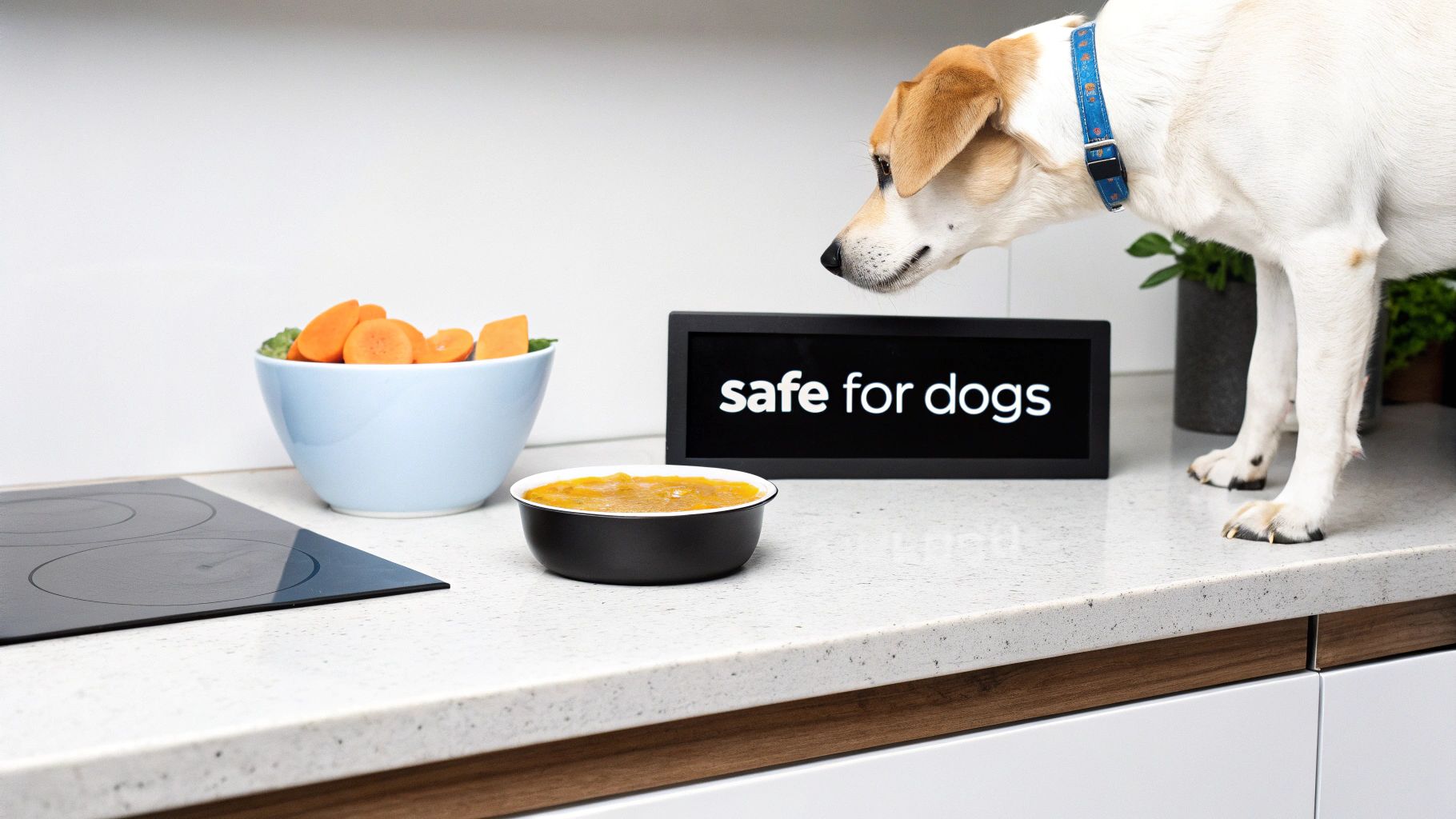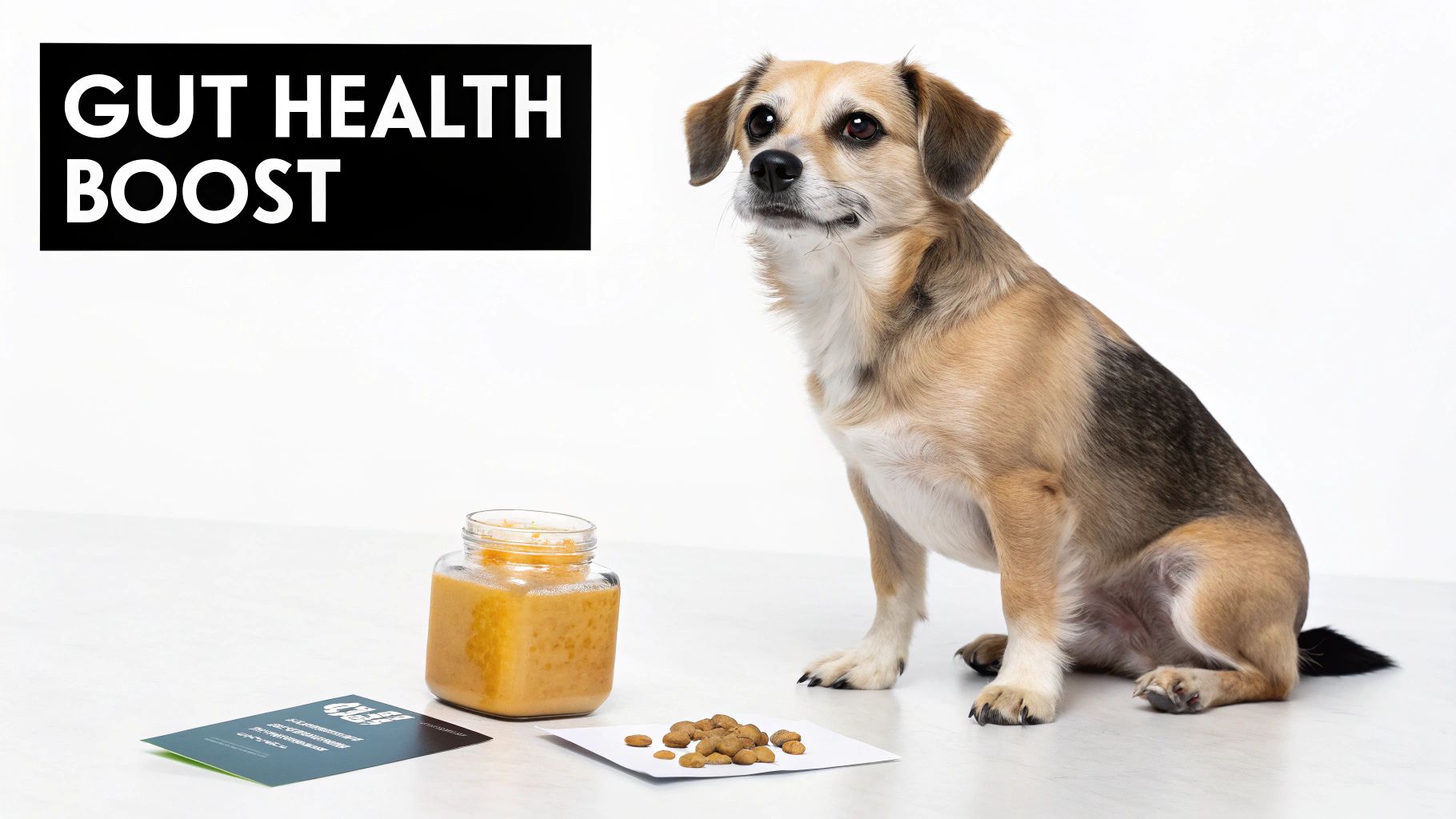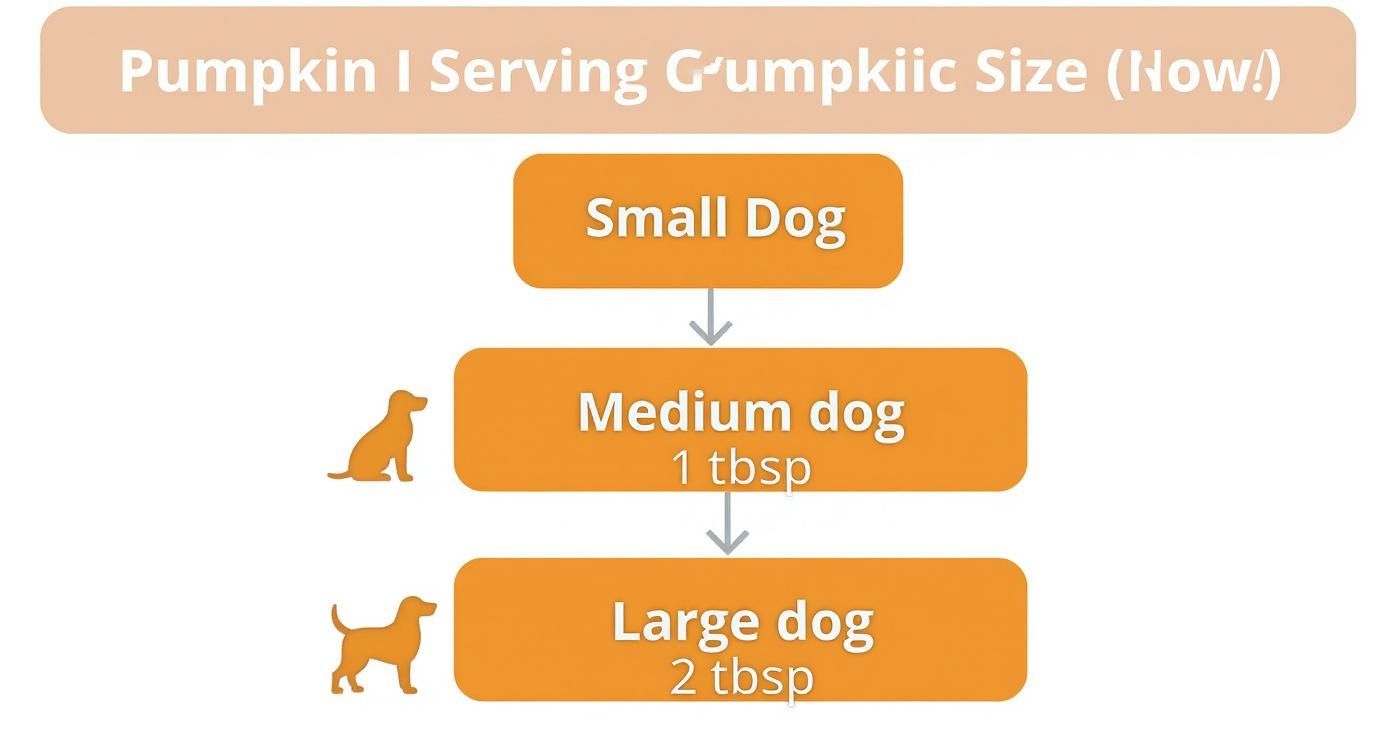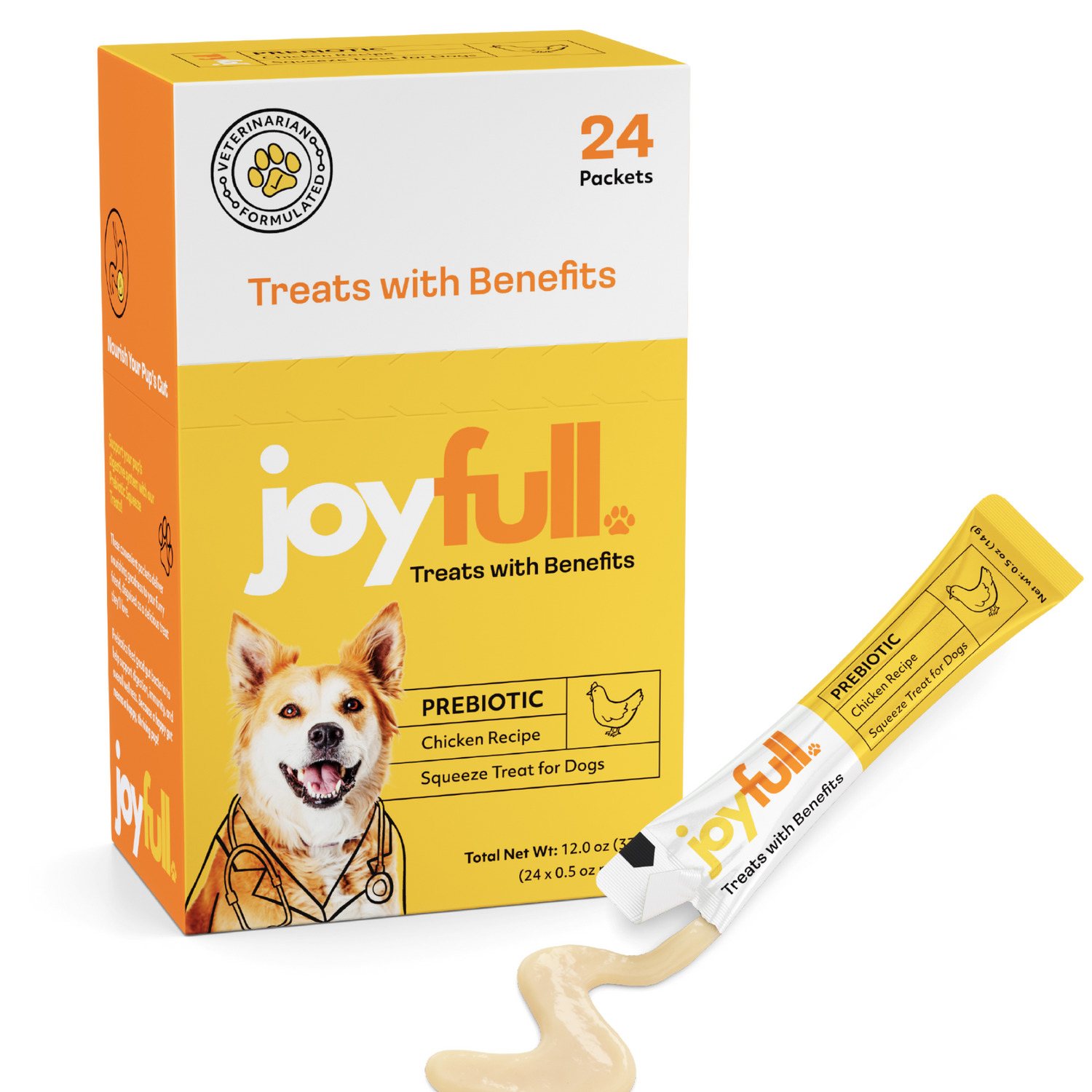
Can Dogs Eat Pumpkin? Your Complete Pup-Safe Guide
Yes, dogs can absolutely eat pumpkin, and it can be a fantastic, healthy addition to their diet when you serve it the right way. The golden rule is to stick with plain, cooked pumpkin or 100% pure canned pumpkin puree.
What you want to steer clear of is the sweet stuff, like pumpkin pie filling, or raw pumpkin. These can lead to an upset stomach and might even contain ingredients that are harmful to your pup.
Your Quick Guide to Pumpkin for Dogs
When you see all those pumpkin-flavored treats on pet store shelves every fall, it's easy to wonder if giving your dog the real deal is a good idea. The answer is a big yes, but knowing the specifics is key.
Think of pumpkin as a healthy, fiber-rich supplement, not a replacement for their regular meals. It's packed with vitamins and antioxidants that are great for their digestion and immune system. For a deeper dive into all the benefits, check out our comprehensive guide on pumpkin for dogs.

Just remember, moderation is everything. Any treats or supplements, including pumpkin, should only make up about 10% of your dog’s daily calorie intake. This keeps their diet balanced and prevents them from packing on extra pounds.
Pumpkin for Dogs Quick Reference Guide
To make things super simple, I've put together a quick chart. This will help you see exactly what kind of pumpkin is a "go" and which ones are a definite "no."
| Pumpkin Type | Is It Safe? | Key Considerations |
|---|---|---|
| Plain Canned Pumpkin | ✅ Yes | This is your best and easiest choice! Just make sure the can says 100% pure pumpkin and not pie filling. |
| Fresh, Cooked Pumpkin | ✅ Yes | A great option. You can steam or bake fresh pumpkin, but be sure to serve it plain—no salt, spices, or oils. |
| Pumpkin Pie Filling | ❌ No | Definitely avoid this. It’s loaded with sugar and spices like nutmeg, and some may contain xylitol, which is toxic to dogs. |
| Raw Pumpkin | ❌ No | Raw pumpkin is tough for dogs to digest and can easily cause an upset stomach. It’s best to cook it first. |
So, next time you're at the store, feel confident grabbing a can of pure pumpkin for your furry friend. It's a simple way to add a little nutritional boost to their bowl.
What Makes Pumpkin So Good for Dogs?
Pumpkin is more than just a festive fall decoration—it's a nutritional all-star for our canine friends. When people ask, "can dogs eat pumpkin?" the answer is a big yes. Think of it as nature's own little wellness kit, packed with vitamins and fiber that can do wonders for everything from their digestion to their immune system.

Its real claim to fame is its amazing fiber content. This fiber works like a master regulator for your dog's digestive system, cleverly tackling two opposite issues. If your dog has diarrhea, the fiber helps soak up extra water in the gut, which firms up their stool. On the flip side, for a constipated pup, that same fiber helps get things moving again.
This dual-action benefit makes pumpkin a fantastic tool for promoting a healthy gut. For an even bigger digestive health boost, you could talk to your vet about pairing pumpkin with other gut-friendly supplements. If you're curious, we have a great guide on the best probiotics for dogs.
A Powerhouse of Essential Nutrients
Beyond its digestive magic, pumpkin is absolutely loaded with vitamins and minerals that provide some serious health perks for your dog. It's an incredible source of Vitamin A, which is vital for good vision and a robust immune response.
Pumpkin is widely recognized as a beneficial dietary supplement for dogs in major markets like the United States and Europe due to its high fiber and low calorie count.
That classic bright orange hue? It comes from beta-carotene, a powerful antioxidant that helps protect your dog's cells from damage. But that's not all. Pumpkin also delivers a host of other key nutrients:
- Vitamin C: This helps keep inflammation in check and supports healthy, happy joints.
- Potassium: An essential mineral that is crucial for proper muscle function and recovery after a long day at the park.
- Vitamins and Minerals: A cocktail of Vitamins A, C, and E, plus minerals like potassium and iron, all work together to promote a shiny coat, healthy skin, and a strong immune system. You can get more details on pumpkin's nutritional profile on chewy.com.
Just by mixing a spoonful of plain, canned pumpkin into their food, you’re giving them a low-calorie, nutrient-packed boost that supports their total well-being from the inside out.
How to Prepare Pumpkin for Your Dog
https://www.youtube.com/embed/X1FHs8AC-eo
So, you're ready to add some pumpkin to your dog's diet? Great! The good news is, it's incredibly simple, whether you're grabbing a can from the pantry or have a fresh one sitting on your counter. The golden rule is to keep it plain—no extra ingredients needed.
By far the easiest way to serve pumpkin is using 100% pure canned pumpkin. It’s already cooked, smooth, and ready to go right out of the can. This is where you need to put your detective hat on and read the label carefully. You're looking for "100% pure pumpkin," not "pumpkin pie filling."
That pie filling is a huge no-no for dogs. It's packed with sugar and spices like nutmeg, which can be toxic. Even worse, some sugar-free versions contain xylitol, an artificial sweetener that's extremely dangerous for our canine companions.
If you're ever unsure, just check the ingredients list. It should have one thing, and one thing only: pumpkin.
Preparing Fresh Pumpkin from Scratch
If you'd rather go the fresh route, that works too! It just takes a little bit of prep work. Never, ever give your dog raw pumpkin. It’s tough, hard for them to digest, and can easily lead to an upset stomach.
Here’s how to cook it up safely:
- Cut and Clean: Slice the pumpkin in half and scoop out all the seeds and stringy bits. Pro-tip: you can save those seeds and roast them later for a crunchy, separate treat!
- Cook Until Soft: Lay the pumpkin halves cut-side down on a baking sheet. Pop them in the oven at 350°F (175°C) and bake until the flesh is tender enough to poke easily with a fork. Steaming works just as well.
- Cool and Puree: Let the cooked pumpkin cool down completely. Then, just scoop the soft flesh out of the skin and mash it up or run it through a blender until it's smooth.
Remember to serve it completely plain—no salt, sugar, oil, or spices. You can store your homemade puree in the fridge for a few days or freeze it in ice cube trays for easy, pre-portioned servings down the road.
One last word of caution: steer clear of decorative pumpkins. A jack-o'-lantern that's been sitting on the porch can harbor mold and bacteria, which can make your dog seriously ill. Always stick with fresh, plain pumpkin to keep your furry friend happy and healthy.
Finding the Right Pumpkin Serving Size for Your Dog
Pumpkin can be a fantastic addition to your dog's diet, but it’s one of those things where more is definitely not better. Think of it as a healthy supplement to boost their regular meals, not a replacement for them. Giving too much can actually cause the very digestive issues you're trying to prevent.
The goal is to find that perfect balance. A great rule of thumb for any treat, including pumpkin, is the 10% rule. This just means that treats shouldn't account for more than 10% of your dog’s total daily calories. This simple guideline ensures they're still getting the core nutrition they need from their balanced dog food.
If you want to get really precise with their overall diet, using a dog food portion calculator can help you dial in their exact daily calorie needs.
When you first introduce pumpkin, it’s always best to start small. Just a little bit at first lets you see how their system handles it. Every dog is unique, so this slow-and-steady approach helps you find the ideal amount for your pup without any tummy troubles.
Daily Pumpkin Serving Guide by Dog Weight
To take the guesswork out of it, here are some general serving suggestions for plain, canned pumpkin based on your dog's weight.
| Dog Size | Weight Range | Recommended Daily Amount |
|---|---|---|
| Extra-Small | Under 10 lbs | 1/2 teaspoon |
| Small | 10-25 lbs | 1-2 teaspoons |
| Medium | 25-50 lbs | 1-2 tablespoons |
| Large | 50+ lbs | 2-4 tablespoons |
Pro Tip: Always start on the low end of the recommended amount and keep an eye on your dog. If they tolerate it well, you can gradually work your way up, but don't go over the maximum suggestion for their size.
Following these guidelines ensures you're giving them all the good stuff from pumpkin without piling on extra calories or upsetting their digestive balance.
Pumpkin Dangers and What to Avoid
While plain, pure pumpkin can be a fantastic addition to your dog's diet, not everything with "pumpkin" on the label is safe. It's really important to know what to steer clear of to keep your furry friend healthy. The biggest hazards are usually lurking in the baking aisle, disguised as holiday treats but filled with ingredients that are bad news for dogs.
A good way to think about it is comparing a plain baked sweet potato to a sweet potato casserole topped with marshmallows. One is a simple, healthy vegetable; the other is a dessert loaded with extras a dog’s digestive system just isn't built to handle. That same logic applies here.
The number one thing to avoid is canned pumpkin pie filling. This isn't just pumpkin—it's a pre-made mix loaded with sugar and spices like nutmeg, which can be toxic to dogs, especially in larger quantities. Anything labeled "pumpkin spice" should also be a red flag.
Hidden Threats in Pumpkin Products
This is where you have to put on your detective hat and become a master label-reader. Many of these processed pumpkin products contain additives that are downright dangerous for dogs.
The American Kennel Club often reminds pet owners that pumpkin pie filling and anything with "pumpkin spice" can contain harmful ingredients like nutmeg and the artificial sweetener xylitol. To be safe, always stick to 100% pure pumpkin and run it by your vet first. You can find more great food safety recommendations on chewy.com.
Here are the top ingredients to look out for on any label:
- Xylitol: This sugar substitute is extremely toxic to dogs. Even a small amount can cause a sudden, life-threatening plunge in blood sugar.
- High Sugar Content: Just like in people, too much sugar can lead to weight gain and throw your dog's digestive system out of whack. It can also cause some seriously uncomfortable gas. If you're curious about other gassy culprits, we have a helpful guide on why your dog might have gas.
- Harmful Spices: Nutmeg is a big one. It contains a compound called myristicin, which can cause symptoms like disorientation, a racing heart rate, and even seizures in dogs.
This handy infographic breaks down the recommended starting serving sizes for pumpkin based on your dog's weight.

As you can see, a little bit of the right kind of pumpkin goes a long way. This ensures your dog reaps all the healthy benefits without any of the scary risks.
What About the Pumpkin Seeds and Guts?
When you’re carving a jack-o'-lantern, you end up with a big pile of stringy guts and seeds. It's a classic autumn dilemma: can your dog have some of this pumpkin "inside stuff"? The short answer is yes, but there's a key difference in how you should handle the guts versus the seeds.
The slimy, fibrous guts are totally fine for your dog and pack the same nutritional punch as the pumpkin's flesh. Feel free to cook and puree them right along with the meat of the pumpkin. It makes a fantastic, simple food topper with no extra fuss required.
How to Safely Prepare Pumpkin Seeds
Now, pumpkin seeds are a different story. They need a bit of prep work before they're safe and healthy for your pup. Never let your dog snack on them raw—they can be a serious choking hazard and are really tough for their system to break down.
To make them dog-friendly, you need to clean, roast, and grind them.
- First, clean and dry the seeds completely. Get all that stringy pulp off.
- Next, roast them plain on a baking sheet until they're golden. It’s crucial not to add any salt, oil, or spices.
- Once they've cooled down, grind them into a powder. A coffee grinder or spice grinder works perfectly for this.
This extra effort is worth it because it unlocks all the good stuff inside. Pumpkin seeds are loaded with zinc, magnesium, and copper, which are great for your dog's metabolic health and can even help give their coat a beautiful shine. Grinding is the secret—it lets your dog absorb all those nutrients without any risk.
You can find even more helpful tips about feeding pumpkin to your dog at dogids.com.
Got Questions About Pumpkin for Dogs? We've Got Answers.
Even with all the benefits laid out, you might still have a few questions lingering. That's completely normal! Let's clear up some of the most common queries so you can feel totally confident about adding this superfood to your dog's diet.
So, does pumpkin really help an upset stomach? It absolutely can, and it's all thanks to its incredible fiber content. Think of it as a digestive multi-tasker. For diarrhea, its soluble fiber soaks up extra water in the gut, which helps firm things up. For constipation, that same fiber adds bulk to the stool, helping everything move along smoothly.
Another big question is about how often it's safe to give. Can dogs have pumpkin every day? Yes, they can, but the golden rule here is moderation. You have to stick to the right serving size for your dog's weight. Too much of a good thing, even fiber, can backfire and cause digestive issues.
Should I Talk to My Vet First?
In a word: yes. It’s always a smart move to run any new dietary additions past your veterinarian.
This step is non-negotiable if your dog has any pre-existing health issues, like diabetes or chronic kidney disease. What’s beneficial for one dog might not be for another, and your vet knows your pup's specific health profile best.
A quick chat with your vet ensures that you're making the right call for your dog's individual needs. It helps you tailor their diet safely, turning a good idea like adding pumpkin into a great one.
If you love diving deep into what keeps your dog healthy and happy, you might want to explore broader animal care topics and courses to expand your knowledge even further.

